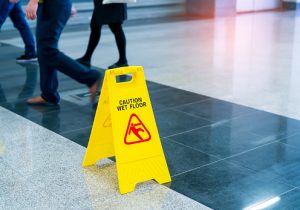 Slick floor surfaces, wires, clutter, and debris — these risk factors are responsible for the majority of workplace slip, trip and fall accidents that leave workers with serious or life-threatening injuries. You see them everywhere: on construction sites, in restaurants, offices, and grocery stores.
Slick floor surfaces, wires, clutter, and debris — these risk factors are responsible for the majority of workplace slip, trip and fall accidents that leave workers with serious or life-threatening injuries. You see them everywhere: on construction sites, in restaurants, offices, and grocery stores.
The National Safety Council (NSC) has identified the industries with the highest number of injuries related to slips, trips and falls in 2016. They include:
- Construction — 24,700 injuries and 384 fatalities
- Manufacturing — 22,040 injuries and 49 fatalities
- Wholesale trade — 10,250 injuries and 21 fatalities
- Retail trade — 29,830 injuries and 29 fatalities
- Transportation and warehousing — 23,490 injuries and 46 fatalities
- Professional and business services — 22,090 injuries and 111 fatalities
- Education and health services — 43,660 injuries and 18 fatalities
- Government — 63,350 injuries and 44 fatalities
Slip, trip, and fall injury facts
Staggering numbers like this should have employers alarmed. Unfortunately, falls in the workplace are a widespread problem, and are the second leading cause of preventable injury across all industries, according to NSC injury facts.
The most common injuries due to falls include:
- Sprains, strains, and tears — 26%
- Soreness and pain — 21%
- Bruises and contusions — 17%
- Other injuries — 9%
Workplace falls are preventable - here's how
Tripping hazards can be eliminated in the workplace simply by making sure tools, wires, debris, and other clutter are cleared from walking areas. In addition, employers should make sure their workplace is well-lit. Uneven surfaces should either be repaired as soon as possible.
Slippery surfaces, on the other hand, aren't always as easily seen. Once they are identified, it's important that management acts fast. An NSC article urges employers to ensure they have the proper signage in the event of a spill, leak, or other incidents that can create slipping hazards.
When utilizing signs, employers should follow the Occupational Safety and Health Administration's (OSHA) regulation 29 CFR 1910.145. The guidelines included in this regulation include:
- Ensuring that specific signs are used to address certain risks
- Educating employees on which risks each sign addresses
- Making sure that all signs are rounded on the edges and show hazards that could harm employees
- Making sure the head of bolts are fastened and don't pose a hazard to employees
- Ensuring that the words used on a sign are legible and clear
- Ensuring that slipping hazard signs have a yellow background, black letters, and a safety alert symbol
Make Fall Safety a Priority
Falls can still happen on the job, despite any safety measures taken by your employer. If you were injured in a work-related fall, it may have been caused by a recent hazard that wasn't yet addressed or by a simple misstep on your part.
Luckily, workers' compensation in California is a no-fault system. That means, no matter who was at fault for causing your accident, you may still be eligible for benefits to cover your medical expenses and lost wages. An experienced San Diego attorney can review the details of your accident and help you explore your legal options.
To get started, contact McLaughlin & Sanchez today.
